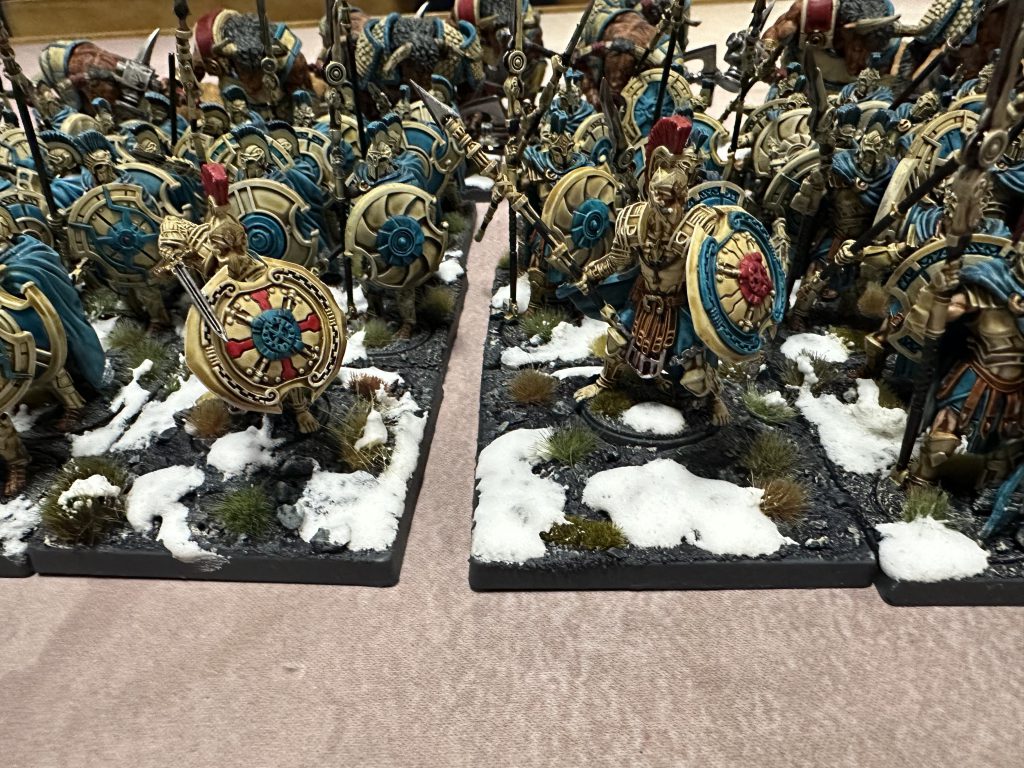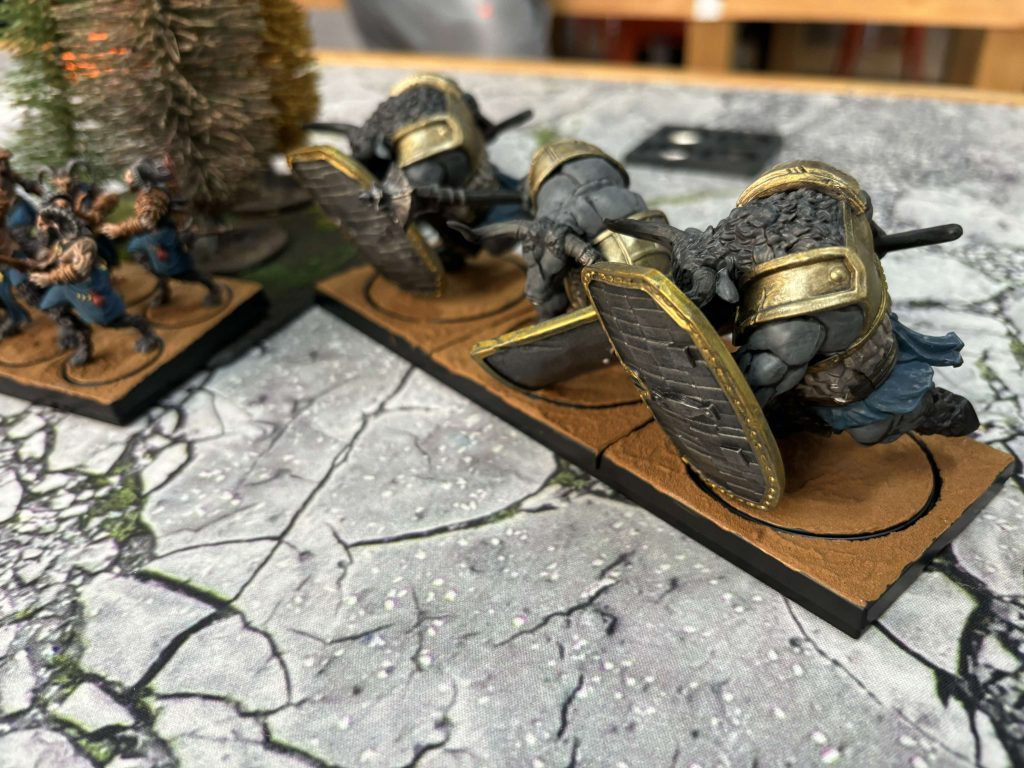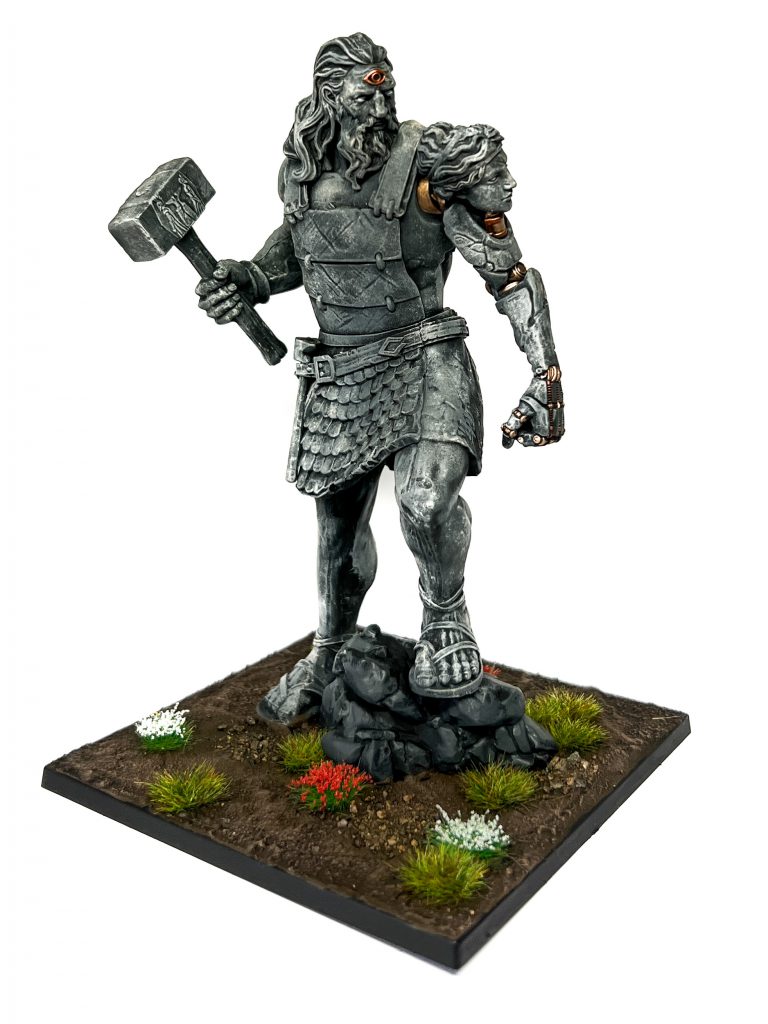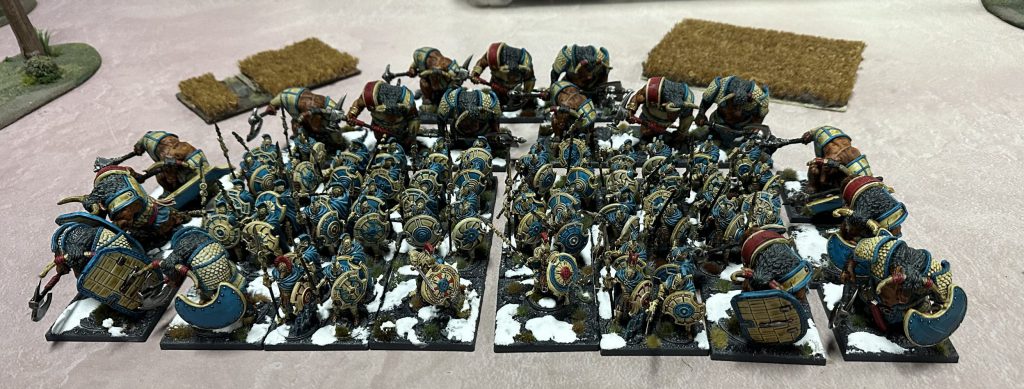Today is the first in a series of articles taking a look at different factions from the skirmish version of Conquest: First Blood (FB). While some of the regiment’s ability might be familiar to The Last Argument of Kings (LAOK) – the two games play differently, so while regiments might feel familiar it’ll be important to understand the differences and their place on the table.
This series of articles is intended to delve deep into each faction, to give you an edge, and something to think about the next time you brew your own lists.

The City States
The City States in First Blood feels like you are playing a very complete faction. Each of the regiment selections, despite how similar they look, have very clearly defined roles; there are the designated anvils and there are the designated hammers. One could say that City States is an army made up of specialists, if such specialists are carrying the equivalent of medieval machine gun, cows with giant cleavers, and spellcasting giants.
When playing City States, you need to consider the balance of each of these specialists, especially when building your list. Not in the traditional sense of power level, but more of how many elements should you bring into the table. How many shield infantries should I bring? How many minotaurs (answer: a lot)? Should I bring a murder giant? This provides an interesting discourse designed to give the player a puzzle to solve, and we at Goonhammer will provide you some insights to help you build your First Blood warband.
Strengths:
- Selection of units that forms a ‘combo’ with each other
- Flexibility in their command due to their faction identity
- Powerful warmachines that can play the ranged game
Weaknesses:
- A warband can be costly if you start adding the warmachines and giants
- Vulnerable to cleave
- Vulnerable to mass ranged attacks
Army Abilities
Front Line Tactics
The capability to use your command ability during the activation as a free action (instead of doing so before they activate) provides a wonderful layer of flexibility to each City States characters. Instead of activating your characters first so that they can buff a unit within their command range, you can instead take advantage of a more flexible range by buffing something else while also keeping your characters active on the battlefield.
Strategic Stack
This ability is pretty simple: you are able to get a second command stack that allows you to ‘store’ a regiment’s activation later down the line. Chain activating two units at once is a huge tactical flexibility afforded to each City States player and the correct use of this ability will determine a battle’s momentum.
You can use this to finish off key targets without them attempting to recover from their situation, or to see whether an enemy key regiment moved elsewhere or not. The use case for this ability is extremely versatile and this provides a wonderful option for sneaky City States player to plan ahead. Not to mention, many City States characters have an ability that works together with this strategic stack such as giving unit activating from it re-roll to their attacks.
Characters
City States characters represent the pinnacle of stats for a ‘basic’ human faction. Indeed some of their characters have enhanced themselves with technology, which brings their stats much higher than their human counterparts.
Polemarch

The Polemarch is a badass fighter that wants to be fighting the enemy every single turn. They have a good stats line for a human fighter, even rivalling the Konugyr of the Nords. Polemarch do not need much in terms of artifact support, but adding a Serrated Blades to give them deadly blades can turn those five attacks into potentially something more.
Tip of the Spear is a unique ability that denies a regiment from seizing objectives when they are being engaged by the Polemarch, and they can swap between Dori and Xyphos – one prioritizes engagement range, and the other prioritizes cleave.
For signature regiments, the Polemarch wants to bring Thorakites and Agema. They give them Unstoppable, an ability that adds +2” to charge range plus an additional march. On top of that they also want a Thyrean or two to give said unit a re-roll on a failed morale test of 6.
All this ability is designed to do one thing: to deliver the murder blender machine into the enemy as soon as possible. Death or glory!
Aristarch
On the other side of the spectrum, we have the Aristarch, who does not exactly prefer to be near the front line. He can hold his own in a fight if you invest into his relics, with Inscription of the Blacksmith to give him cleave and re-roll to clash, but most players will bring this character for his strategic ability.
Polearm Tactics ensures that those pesky support rules lose their drawback of re-roll when they are in 1” of the enemy. This is doubly important as the Aristarch’s signature regiments are the Hoplites and Phalangites, both gaining the counter-attack rule and +1 march thanks to the Riposte! ability. Iron Resolve will also help with the somewhat low resolve characteristic of this unit by negating any morale penalty from the enemy regiment.
Ipparchos
Polemarch but on horse! This combines the great stats of the original unit with cavalry-grade speed. Add the Inscription of the Blacksmith to him and he will deal plenty of damage on the charge, due to him being cleave 2 and having re-roll on the attack. The dread ability, which negates the enemy regiment from being inspired when engaged with him, will also help his survivability due to the somewhat weak defense stats.
Naturally, the Ipparchos’ signature regiments are the Companion Cavalry alongside the two chariots. He gives them additional movement and the ability for them to withdraw without taking a penalty, ensuring that the chariots can always fire their shots.
Where the Ipparchos shines though is his ability to orchestrate a backbreaking charge with the combination of Now! and Hammer and Anvil. The former allows a cavalry regiment to immediately activate after performing a clash or charge action, and the latter gives them additional attacks and extra charge distance if the targeted enemy regiment is engaged with a friendly Hoplites or Phalangites regiment.
Machinist
The first (and only) spellcaster in the City States. His stats line ensures that, like every other spellcaster, he wants to sit in the back and sling spells. It also helps his cause that he has a ranged attack to potentially deter enemies from moving closer.
Similar to the Ipparchos in terms of his ability to combo with the rest of the army, the Machinist brings an unparalleled mobility to a City States force. Mobility gives a friendly regiment a +3 to their March characteristic at the drawback of -1 defense and losing shield. Then add Synchronized Formation into the mix, giving them an additional +4 to their charge distance. Suddenly, your Clockwork Hoplites are flying off your side of the battlefield, giving them a potential charge distance of 12”!
Eidolon
Lastly we have the mechanical monstrosity of the Eidolon. This brute character has a strong statline skewed more towards offense than defense. Notably, it doesn’t need Inscription of the Blacksmith since it already has cleave naturally.
Unsurprisingly, the Eidolon works best with Inquisitors, making them count as an additional model to contest objectives. And it also can choose to give a regiment a ‘marked’ status, giving either additional +2” when charging or an additional cleave +1.
But of course if you bring the Eidolon, you are bringing a melee monster and Combat Directives is how you use that monster. Each turn, you can choose a buff to the Eidolon: +4 attacks but with -1 penalty to clash (which you have flurry for anyway), Parry, or Cleave +3 for when you really need to get rid of that armor. Hint: always pick the +4 attacks.
Warbands
Each of the City States characters prefers their own signature regiments. While the next section will give a broad overview of each of the selections, it is good to keep in mind what characters you want to bring so you can unlock the full potential of these regiments.
Infantry
Hoplites
The humble spear and shield infantry from City States offers a very compelling package for 110 points, mainly being cheap and durable. Having a longer engagement range without the drawback means that the Hoplites have a cheeky charge compared to the other infantry options.
Phalangites
The slightly more expensive infantry option comes with Phalanx Tactics, an ability that will give them re-roll if two regiments are engaging the same target plus the ability to negate enemy bonus when charging. This means that they work best as a frontline regiment to pin the enemy unit in place while the rest of the army does work.
Agema

The badass Agema sports one of the highest number of attacks per model in the City State infantry at two each. They’re a bit more expensive than their alternative selection below, and this is represented well with them having Phalanx Tactics as well as a better Clash stat of 3. Most City State warbands would like a regiment of these due to how good they are at dealing damage.
Thorakites
On the opposite end of the spectrum, the Thorakites are fast moving infantry with their Vanguard rule, allowing them a free March before the start of the game. This Regiment works best as a skirmisher unit, moving in and grabbing objectives early before either army fully gets into position.
Satyroi
While the Agema are designed to be more durable with their higher defensive stats and the Phalanx Tactics rule, the Satyroi are designed to operate as an opportunist regiment. With their Flank ability allowing them to appear in the reinforcement zone and a higher movement of six, these sneaky goats want to get on the flank of the opponent’s army and deliver a precise blow in their lines. Ranged attackers beware!
Selinoi
Currently the only ranged infantry that City States have access to, these humble goat archers have the unique rule of Supporting Fire – meaning that they can get line of sight through friendly infantry models with no penalty. Park them behind a regiment of Hoplites or Phalangites and fire away!
Sacred Band
Prostagma! Your reference to Age of Mythology did not escape us, PB games. Prostagma aside, this regiment represents the toughest veterans of the City States army. They can hold ground by themselves with their defense 3 and hardened 1 ability, not to mention their Resolve 4 alongside Fearless – meaning that wherever the Sacred Band park, they will most likely stay there. Not to mention, they also have access to incantations that can heal them or re-roll morale tests of 6.
Clockwork Hoplite
No resolve? No problem. This mechanical creation of the City States have no resolve test, meaning that they will not take additional damage after combat from morale test and they auto-succeed any test that requires them to roll resolve. They do pay for their defensive abilities with a hefty price tag of 150 points, the same as a unit of Agema. Carefully selecting between these two hammer and anvils is a key choice for a City States commander to make during the course of army creation.
Cavalry / Brute
Companion Cavalry
The signature unit of Alexander (though he does not exist in this setting), this fast cavalry hits hard but is not as durable as more traditional horse-mounted units. With movement 8 and Unstoppable—adding an extra 2” to charge—they can threaten charge very well across large stretches of the board. But as noted, defensively they are not great, with only Defense 2 and Evasion 1, so do not bring them into a protracted fight!
Minotaur Haspists
The first of the two minotaur regiments, the Haspists are designed to be the more defensive of the pair. With 3 defense including shield, they are there to take hits while dishing them back in return.

Minotaur Thyreans
Crazy cow charge! With both cleave 3 and Linebreaker – an ability to ignore enemy shields – this unit will melt armor like a knife through hot butter. While less durable than their shield-wielding brethren, I would highly recommend this bovine assault unit in your regiment to hit high defense targets.
Inquisitors
Costing 10 points more than the Minotaur Thyreans, they sport a higher speed at movement 7 and a higher number of attacks at 6, along with Flurry to make their attacks more accurate. The key difference between this regiment and the Thyreans is that they operate best at eliminating regiments with lower defense, whereas the Thyreans are designed to cleave through armor.
Flogobollon and Skorpios
The two chariots function in the same way: As fire support platforms for your regiments. The key difference is that one has a closer range shot that can carve through lower defense regiments at barrage 7 and Torrential Fire – an ability that can double the number of shots fired. Meanwhile the Skorpios sports longer-ranged fire, albeit with less potential for the number of dice to double – but the ability Fiend Hunter gives the Skorpios re-roll to shoot down other cavalry, brute or even monsters. Take your pick: a magical shotgun that can double your shots or a rapid-fire machine gun!
Monster
Promethean Giant
The Promethean represents a more support-oriented monster compared to its fiery brethren. Damping Force gives a bubble of re-roll failed defense and morale stats while Magnetic Balance gives an additional clash stats and re-roll failed attack roll of 6. Of course, being a giant monster still has its benefits, with a large number of attacks, decent defensive stats at 3 defense and 18 wounds.

Hephaestian Giant
By fire be forged..err, wrong series. With a higher cleave stat of 3 and two offensive incantations, the Hephaestian wants to burn regiments to the ground. Bring this fiery giant if you want to add more firepower to your list in more ways than one.
Talos
The Talos is a unique monster in that it’s the only monster regiment with a command ability. Flavor-wise, it is a giant that was designed to bridge the communication between the giants and humans, so having the ability to use Command is a unique and flavorful take on the lore, and gives you potentially a third character on the battlefield that can issue these powerful orders.
Talos is tough; it can heal itself with the Second Wind command and works well with any of the Characters in City States. Follow ensures that infantry regiment can keep up with their movement of 7, Hold Your Ground can ensure that those regiments can contest objectives.
Officers
The key difference between officer models in First Blood compared to LAOK is that here, the models are really good. Most officer models is cheaper than a model of infantry with the statline of almost double that of a normal model. The only drawback is that you can only bring one per regiment.
Andromachos
The first of the two new officers to the City States. There’s not much here in terms of Command ability, but at 50 points, it hits harder than three Agema stapled together. This officer wants to be a Polemarch one day with a built-in Flurry and the ability to negate enemy models’ ability to score if they are engaged with him.
Dorilates
A simple officer whose main purpose is to give friendly Hoplites or Phalangites a re-roll to their attack thanks to the Dorastismos! command. If only they were able to give their re-roll to some more impressive units, then maybe this officer would have been the pick.
Lochagos
This unique officer has Carry Orders ability – which essentially replicates one of your character’s commands. Here are a couple of fun abilities for your Lochagos to copy:
- Mechanist’s Liquid Fire: Now two regiments suffer -1 to their resolve and re-roll successful resolve test
- Aristarch’s Iron Resolve: Now two regiments cannot suffer penalty to their resolve
Experiment around with this officer to see what kind of commands you can replicate!
Sacred Band Officer
While not necessarily a traditional officer model since you get them from the Sacred Band box, this veteran officer always counts the regiment it belongs to as being drawn from the strategic stack. Meaning, for example, if you have an Aristarch character, the regiment always count as double model for the purpose of seizing objectives, or if you have the Polemarch character, they always gain re-roll to their clash.
Building a First Blood City States List
City States works best in a combined arms list: A strong core of shield infantry to hold ground alongside a powerful set of brutes, warmachines and giants to form the bulk of the main fighting force. Character selection also matters, because Characters have their own signature regiments which will affect list building.
Consider the following as a ‘guideline’ for a City State list:
- 1-2 Signature Regiments: For example, Agema with Polemarch or Companion Cavalry/Chariots with Ipparchos
- 1-2 Objective Holders: Clockwork Hoplites, Hoplites, Phalangites are all durable regiments that can function well to hold objective zones
- 1-2 Assault: These can be in the form of Agema, Minotaur Thyreans, or Satyroi. Strong, yet not-so-durable options that have multiple attacks which cleave armor.
- 0-1 Warmachines: Skorpios or Flogobollon are very powerful combat pieces that can provide a bit of a ranged game to a City States List.
- 0-1 Giants: Consider Talos as an option as a durable model that can hold an objective zone by itself. The monster options are considered a luxury depending if your list can afford them.
Sample City States list:
Combined Arms [995/1000]
The City States
* Polemarch [20]: Serrated Blades
* Agema (6) [250]: Sacred Band
* Agema (6) [270]: Andromachos
* Flogobollon (1) [190]:
* Hoplites (5) [135]:
* Minotaur Thyreans (1) [130]:
The two Agema work as both a durable threat as well as a way to deliver the powerful Andromachos to the enemy regiment. Sacred Band Officer works here as a way to give them flurry. Flogobollon acts as a fire support to present some ranged threat to the opponent and put them in an engage or be damned situation.

Wrapping Up
Whether you are wielding a mass of infantries with shield or running a more specialized cavalry lists and chariots, the City States have plenty of playstyles to accommodate your strategy. Just don’t forget to brush up your Greek when playing them otherwise you will only yell Prostagma! every turn.
Have any questions or feedback? Drop us a note in the comments below or email us at contact@goonhammer.com. Want articles like this linked in your inbox every Monday morning? Sign up for our newsletter. And don’t forget that you can support us on Patreon for backer rewards like early video content, Administratum access, an ad-free experience on our website and more.
As always if you want to get 10% off and support Goonhammer you can make your Conquest purchase by clicking here for US/Canada or here for EU/rest of world. You’ll also need to enter code “goonhammer” at checkout.


